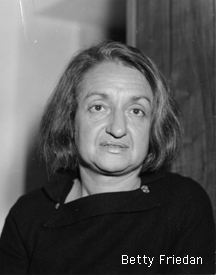NEWS & LETTERS, September-October 2011
'A Strange Stirring'
A Strange Stirring: 'The Feminine Mystique' and American Women at the Dawn of the 1960s, by Stephanie Coontz (Basic Books, New York), 2011.
A Strange Stirring is an examination of the situation of U.S. women during the years surrounding the 1963 publication of Betty Friedan's book The Feminine Mystique and how it helped the feminist movement change our culture. Friedan coined the term "Feminine Mystique" to describe what was going on in the lives of middle-class women diagnosed with the mysterious ailment psychologists called "the housewife syndrome." Friedan explained that women suffered depression because they did not have the ideal lives that patriarchal society claimed. They had no opportunity to engage in creative, meaningful work.
 Coontz says it's hard today to understand the level of contempt aimed at women in the 1950s and 1960s as well as the negative image that women had of themselves. The book describes some of that period's brutally anti-woman laws. Also, psychologist Sigmund Freud's popular theories of psychoanalysis caused women to live in fear that, whatever they did, they would "emasculate" men and make their children "neurotic." Both the legal system and psychoanalysis assumed that women and men were like two different species, marked not only by completely different abilities and interests but by a supposed psychological need for male dominance and female submission. Coontz says it's hard today to understand the level of contempt aimed at women in the 1950s and 1960s as well as the negative image that women had of themselves. The book describes some of that period's brutally anti-woman laws. Also, psychologist Sigmund Freud's popular theories of psychoanalysis caused women to live in fear that, whatever they did, they would "emasculate" men and make their children "neurotic." Both the legal system and psychoanalysis assumed that women and men were like two different species, marked not only by completely different abilities and interests but by a supposed psychological need for male dominance and female submission.
WHY FRIEDAN'S BOOK WAS A MUCKRAKER
White middle-class women felt guilty even about feeling frustrated because they had materially better lives than their parents had during the Depression and were aware that African Americans were going through a much harder time struggling for their rights. Friedan countered this by discussing psychologist Abraham Maslow's theory of the hierarchy of needs, which states that self-actualization is a true need after basic survival needs are met. Freidan also pointed out that men's need for self-development is routinely recognized and celebrated.
Coontz says Friedan "turned Freud on his head" by stating that any women who did try to control their husbands or sons really needed to control their own lives (rather than accept a submissive, "feminine role") in order to have healthy relationships with men. Simplistic, conservative marriage "experts" thought that women's independence and participation in the workforce would damage marriages, but Coontz, an expert on the U.S. family, states that, after initially rising when more women entered the workforce, divorce rates fell. Today, they are lowest in states with over 70% of married women in the workforce. Couples with egalitarian gender views report higher marital quality.
Critics complain that Friedan's book did not discuss working-class women who were in the workforce by necessity. Friedan did not want to mention her past as a labor activist because she had seen the damage done to Leftists by McCarthyism. When she founded the National Organization for Women (NOW) and became its first president, most of NOW's early court cases focused on the rights of working-class and African-American women. Coontz discusses mail Friedan received from women stating they did feel they were contributing to society with working-class jobs and that their main reason for quitting was overwork because their husbands refused to do housework or childcare.
THE FEMININE MYSTIQUE STILL LIBERATES
Coontz also tackles Friedan's own myth that she had single-handedly revived the feminist movement. It was still there in organized form as professional women's groups that pressured Presidents behind the scenes on issues such as equal pay. These earlier groups allowed feminists to network and later form NOW.
Coontz asks whether "men and women can, as Friedan predicted, 'finally see each other as they are' rather than through the distorted lens of gender stereotypes?" She briefly discusses new mystiques such as the Motherhood Mystique, in which mothers are afraid they are not doing enough for their children when they are actually spending more time with them than did housewives of the 1950s and 1960s.
Although The Feminine Mystique is outdated by its reactionary fears that repressed housewives caused homosexuality and female promiscuity in their children, it still liberates modern readers, especially those living in conservative areas. The rhetoric aimed at women in the 1950s and 1960s is eerily similar to that of the religious Right today. The situation for women described in both books is one that our society could slip back into, but both Coontz and Friedan show a way out.
--Adele
|

